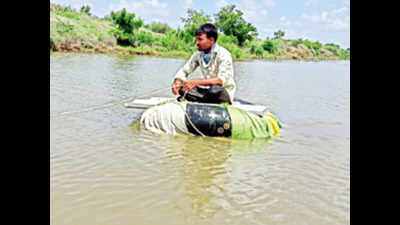- News
- City News
- rajkot News
- Gujarat: Road under 10 feet water, farmers use makeshift boats to reach fields
Trending
This story is from June 26, 2020
Gujarat: Road under 10 feet water, farmers use makeshift boats to reach fields
For years now, monsoon turns these two remote hamlets in Badhda village of Savarkundla taluka in Amreli district into Venice of sorts. Reason? A road, the villagers’ lifeline, submerged in 10 feet of flood water.

A farmer using a rubber boat to reach his field near Savarkundla
By: Dilip Jiruka
RAJKOT: For years now, monsoon turns these two remote hamlets in Badhda village of Savarkundla taluka in Amreli district into Venice of sorts. Reason? A road, the villagers’ lifeline, submerged in 10 feet of flood water.
But, unlike the Venetians who use gondolas as the only means of commuting owing to the topographical necessities, 300-odd villagers in Surajwadi and Badhda villages have to commute in rubber dinghies thanks to the fury of nature and apathetic government authorities.
The two villagers are linked by the Surajwadi River and around 10 years ago, a bund was built on the river, more than 10 feet higher than the road that runs parallel to it, opening the floodgates of misery.
“The road leading to our farms gets submerged in 10 feet water during monsoon, which remains so for more than six months. We are left with no option but to navigate this “manmade river” in dinghies,” said Hasmukh Patel, a farmer from Badhda village.
Around 20-odd farmers’ families are forced to commute in the rubber flotillas to their farms travelling 14 km up and down every day. And the problem persists throughout the groundnut and cotton crop cycle — from sowing to harvesting.
“By the time we harvest our crops, the road has residual flood water of 2-3 feet but we can drive our heavy vehicles like tractors through it,” said Patel, adding that all repeated entreaties have fallen on authorities’ deaf ears till now.
“We have made several representations before the district administration, urging it to build a bridge on the river, but to no avail,” said another farmer Ansar Sahira.
RAJKOT: For years now, monsoon turns these two remote hamlets in Badhda village of Savarkundla taluka in Amreli district into Venice of sorts. Reason? A road, the villagers’ lifeline, submerged in 10 feet of flood water.
But, unlike the Venetians who use gondolas as the only means of commuting owing to the topographical necessities, 300-odd villagers in Surajwadi and Badhda villages have to commute in rubber dinghies thanks to the fury of nature and apathetic government authorities.
The two villagers are linked by the Surajwadi River and around 10 years ago, a bund was built on the river, more than 10 feet higher than the road that runs parallel to it, opening the floodgates of misery.
The road connects the villages as well as their farms and the villagers had protested to the then BJP MLA, Kalu Virani, about the height of the dam explaining that it will create problems during rains. Though he had assured help, nothing moved since then and as feared, every monsoon the river gets flooded and water spills over the bund and onto the road.
“The road leading to our farms gets submerged in 10 feet water during monsoon, which remains so for more than six months. We are left with no option but to navigate this “manmade river” in dinghies,” said Hasmukh Patel, a farmer from Badhda village.
Around 20-odd farmers’ families are forced to commute in the rubber flotillas to their farms travelling 14 km up and down every day. And the problem persists throughout the groundnut and cotton crop cycle — from sowing to harvesting.
“By the time we harvest our crops, the road has residual flood water of 2-3 feet but we can drive our heavy vehicles like tractors through it,” said Patel, adding that all repeated entreaties have fallen on authorities’ deaf ears till now.
“We have made several representations before the district administration, urging it to build a bridge on the river, but to no avail,” said another farmer Ansar Sahira.
End of Article
FOLLOW US ON SOCIAL MEDIA










